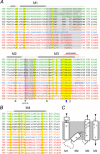Glutamate receptor pores
- PMID: 25556787
- PMCID: PMC4293053
- DOI: 10.1113/jphysiol.2014.272724
Glutamate receptor pores
Abstract
Glutamate receptors are ligand-gated ion channels that mediate fast excitatory synaptic transmission throughout the central nervous system. Functional receptors are homo- or heteromeric tetramers with each subunit contributing a re-entrant pore loop that dips into the membrane from the cytoplasmic side. The pore loops form a narrow constriction near their apex with a wide vestibule toward the cytoplasm and an aqueous central cavity facing the extracellular solution. This article focuses on the pore region, reviewing how structural differences among glutamate receptor subtypes determine their distinct functional properties.
© 2014 The Authors. The Journal of Physiology © 2014 The Physiological Society.
Figures


References
-
- Antonov SM, Gmiro VE. Johnson JW. Binding sites for permeant ions in the channel of NMDA receptors and their effects on channel block. Nat Neurosci. 1998;1:451–461. - PubMed
-
- Beck C, Wollmuth LP, Seeburg PH, Sakmann B. Kuner T. NMDAR channel segments forming the extracellular vestibule inferred from the accessibility of substituted cysteines. Neuron. 1999;22:559–570. - PubMed
-
- Bernard A, Ferhat L, Dessi F, Charton G, Represa A, Ben-Ari Y. Khrestchatisky M. Q/R editing of the rat GluR5 and GluR6 kainate receptors in vivo and in vitro: evidence for independent developmental, pathological and cellular regulation. Eur J Neurosci. 1999;11:604–616. - PubMed
-
- Blanke ML. VanDongen AM. The NR1 M3 domain mediates allosteric coupling in the N-methyl-d-aspartate receptor. Mol Pharmacol. 2008;74:454–465. - PubMed
Publication types
MeSH terms
Substances
Grants and funding
LinkOut - more resources
Full Text Sources
Other Literature Sources
Molecular Biology Databases
Miscellaneous

